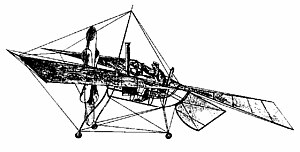Du Temple Monoplane
| Monoplane | |
|---|---|

| |
| The Du Temple Monoplane. | |
| Role | |
| National origin | France |
| Manufacturer | Félix du Temple |
| First flight | 1874 |
| Number built | 1 |
The du Temple Monoplane was a large aeroplane made of aluminium, built in Brest, France, by naval officer Félix du Temple in 1874.
It had a wingspan of 13 m (43 ft) and weighed of only 80 kg (180 lb) without the pilot.
Several trials were made with the aircraft, and it is generally recognized that it achieved lift-off - described by Dollfus as "short hop or leap" and in Flight International as "staggered briefly into the air" - (from a combination of its own power and running down an inclined ramp),[1][2] glided for a short time and returned safely to the ground, making it the first successful powered flight in history though not the first self-powered one.
It was displayed at the 1878 Exposition Universelle ("World Fair") in Paris.
Steam engine

The aircraft used a very compact, high-speed circulation steam engine for which Félix du Temple applied for a patent on 28 April 1876. The engine used very small pipes packed together "to obtain the highest possible contact surface for the smallest possible volume" [3]
- "When he began with the aid of his brother, M. Louis du Temple, to experiment on a large scale, the inadequacy of all motors then known became apparent. They first tried steam at very high pressures, then a hot-air engine, and finally built and patented, in 1876 a very light steam boiler weighing from 39 to 44 lb. to the horse power, which appears to have been the prototype of some of the light boilers which have since been constructed. It consisted in a series of very thin tubes less than 1/8 in. in internal diameter, through which water circulated very rapidly, and was flashed into steam by the surrounding flame."[4]
This type of boiler, which boils the water instantly, has come to be known as a flash boiler. The engine design was later adopted by the French Navy for the propulsion of the first French torpedo boats:
- "Officers and engineers have now made up their opinion regarding Du Temple's steam engine. Everybody proclaims the superiority of its qualities… orders are pouring in from our commercial harbours and from the French government."[5]
See also
- List of early flying machines
- Early flying machines
- Timeline of aviation - 19th century
- History of aviation
Notes
- ^ Gibbs-Smith
- ^ Philip Jarrett "So what's new?" Flight International 21 January 1984 p216
- ^ The patent describes "une demande pour une chaudière à vapeur à circulation rapide donnant la plus grande surface de chauffe possible sous le plus petit volume et le moindre poids."
- ^ Octave Chanute, Aeroplanes : Part III, August 1892
- ^ Felix du Temple (PDF) (in French), archived from the original (pdf) on January 11, 2006,
L'opinion est faite aujourd'hui sur la chaudière Du Temple parmi les officiers et les ingénieurs. Tout le monde proclame ses qualités supérieures… les commandes affluent de nos ports de commerce et de la part du gouvernement français
{{citation}}: Unknown parameter|deadurl=ignored (|url-status=suggested) (help)
References
- Gibbs-Smith, Charles H. (1959), "Hops and Flights: A Roll Call of Early Powered Take-offs", Flight, 75: 468, retrieved 2011-03-03

